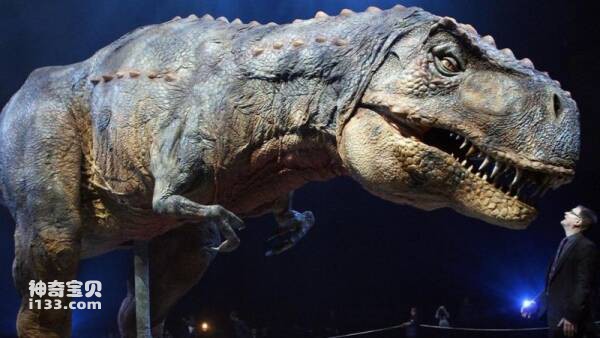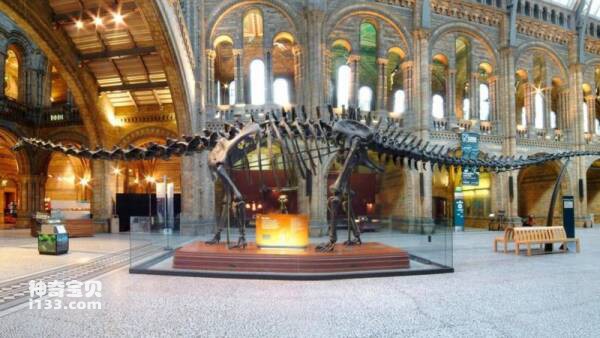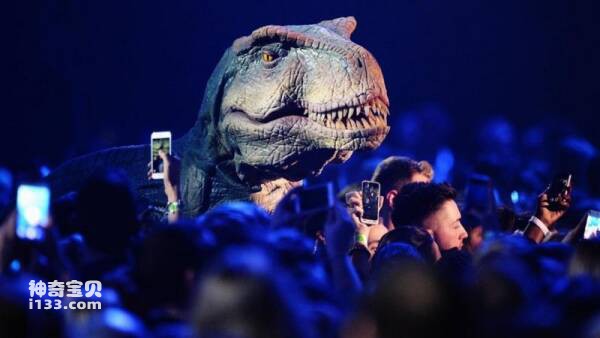It was a disaster we could hardly imagine. 66 million years ago, an asteroid with a diameter of 15 kilometers hit the earth. Its power was equivalent to 10 billion Hiroshima nuclear bombs. The radioactive fireball reduced everything within hundreds of miles to scorched earth, and the impact caused a tsunami that swept halfway around the world. Even the atmosphere may burn, and no animal weighing more than 25 kilograms on land will be spared. In fact, about 75% of all species are extinct. There was no hope for the so-called "non-avian" dinosaurs. Only the small, feathered flying dinosaurs that we now know as birds survived.
But what if history went in the other direction? What if the asteroid missed Earth, or arrived a few minutes earlier? In a recent BBC documentary, The Day the Dinosaurs Died, researchers proposed this hypothetical scenario. Scientists such as Sean Gulick, a geologist at the University of Texas, believe that if the asteroid had arrived earlier or later, it would not have landed on Mexico's Yucatan Peninsula. ) into the shallow waters of the Pacific or Atlantic Ocean. This absorbs some of the energy and limits the diffusion of sulfur particles. It was these sulfur particles that contributed to the suffocating atmosphere in the months and years that followed.
If that were the case, the Earth would still suffer disasters and species extinctions, but some larger dinosaurs might survive. This alternate timeline makes for an interesting thought experiment. Dinosaurists are very excited about this. Will dinosaurs continue to this day? Will new varieties emerge? Will dinosaurs evolve intelligence like humans? Will mammals continue to live in the shadow of the dinosaurs? Can humans evolve – as depicted in the 2015 Disney animated film The Good Dinosaur – and find a way to coexist with dinosaurs?

Giant pterosaurs with huge wings may dominate the sky
However, some researchers believe that even without an asteroid impact, the dinosaur family would have already begun to die. "My view is somewhat unconventional," says Mike Benton of the University of Bristol in England. Dinosaurs will still become extinct due to a colder climate. They lasted until the end of the Cretaceous, but as we know, mammals were diversifying at that time... and the power of dinosaurs had been declining for the previous 40 million years. "Benton believes that even without an asteroid impact, mammals would still have replaced the dinosaurs. One of his 2016 papers argued that dinosaurs replaced extinct species at a slower rate than mammals.
Other experts see things very differently. Tom Holtz, a carnivorous dinosaur researcher at the University of Maryland, also believes that no matter what, 66 million years ago, due to the volcanic eruption and outflow of large amounts of sediment from the Deccan Traps in India, Magma will also cause the extinction of some species on the earth - but he said: "Other than that, after entering the Paleocene (Palaeocene) and Eocene (Eocene), nothing will affect the overall survival of dinosaurs." . That would be a world where dinosaurs from the Cretaceous period could live comfortably. "
Stephen Brusatte of the University of Edinburgh added that dinosaurs diversified as the climate changed over 160 million years. "Until the end of the Cretaceous, dinosaurs were still very adaptable and showed no signs of extinction. They were defeated by asteroids. This shows that this species still has strong evolutionary potential. "
If dinosaurs had survived, what factors would have affected their evolution? Climate change may be the first obstacle. During the Palaeocene-Eocene Thermal Maximum 55 million years ago, the global average temperature was 8 degrees Celsius higher than today, and many places on the earth were covered by tropical rainforests.

Triceratops could have evolved into a fast-moving herbivorous dinosaur, like the mammals that emerged on the grasslands.
In such a greenhouse-like world of lush vegetation, long-necked sauropods might have grown faster, given birth earlier, and shrunk in size. Scientists have learned that some "dwarf" sauropod dinosaurs once existed on European islands in the late Cretaceous. In the mid-Cretaceous, South America's largest tyrannosaurus - 40 meters long and as heavy as two jet planes - was already extinct.
Another trend in the late Cretaceous was the rise of flowering plants, or angiosperms. In the Jurassic, most plants were ferns and gymnosperms (including ginkgo, cycads, and conifers). The nutritional levels of these angiosperms tended to be lower, and sauropods grew in size, driven by the intestinal space required for digestion time and digestive efficiency.
"If plants had continued to evolve in the same direction as in the modern world, herbivorous dinosaurs would have essentially relied on flowering plants as their main food source," says paleontologist Matt Bonnan of Stockton University in New Jersey. Matt Bonnan mentioned, "Because flowering plants are easier to digest, the size of dinosaurs may generally decrease...the large dinosaurs of the Mesozoic Era may become extinct." "
Flowering plants are followed by fruits, which co-evolved with mammals and birds to help plants disperse their seeds. Is it possible that monkey-like dinosaurs evolved using this resource, much as primates evolved? "Many birds also eat the fruits. So it's possible that non-avian dinosaurs also evolved a fruit-based diet," Bonan said.
Brusset agrees: "Some small, feathered dinosaurs could have evolved in the same direction as primates," some of which were already bouncing around tree branches. Others may have started eating honey, passing pollen from flower to flower in the process.

The Tyrannosaurus Rex could have continued to this day, as long as the wildlife reserves and national parks where it lived were large enough to meet its needs for living space.
Another major event was the separation of South America and Antarctica 34 million years ago at the turn of the Eocene and Oligocene epochs. This leads to the formation of circum-Antarctic ocean currents, which in turn contributes to the cooling and drying of the Antarctic ice sheet and global climate. During the Oligocene and later the Miocene, large areas of grassland appeared on the earth.
"Fast-running, thin-legged herbivorous mammals are becoming more common - they used to be able to move slowly and jump into trees to hide, but in the open grassland, they have nowhere to hide." "Holtz said. At this point in history, hoofed herbivores and the carnivores that hunted them suddenly became abundant and diverse.
Darren Naish, a vertebrate paleontologist in Southampton, England, says that in another timeline, fast plant-eating dinosaurs would have been horned relatives of Triceratops or had sharp teeth. Descendants of bipedal, beaked herbivorous dinosaurs similar to dragons.
"Dinosaurs already had a huge evolutionary advantage, whereas mammals took a long time to evolve. "He added. Mammals have a first-mover advantage in adapting to grassland environments. The hadrosaurus had as many as 1,000 teeth as offensive weapons, while the horse only had 40 teeth, so the former could easily chew grass.
Dinosaurs also had better vision than mammals, and they were better able to detect color and detect danger. The beaks of horses and cattle are very flat, which helps them eat harder vegetation close to the ground, so hadrosaurs and sauropods may also evolve flat beaks, and the necks of hadrosaurs may also become shorter to assist in gnawing. Eat the grass at your feet.
Even if dinosaurs survived into the modern era, they would have had to contend with multiple ice ages over the past 2.6 million years. But as far as we know, dinosaurs lived in the Arctic Circle during the Cretaceous. "Perhaps in colder places you would see dinosaurs covered in thick fur from head to toe," Naish said.
"For a hairy tyrannosaurus or dromaeosaur related to Velociraptor, that wouldn't be difficult," said Victoria Arbour, an ankylosaurus expert at the Royal Ontario Museum in Canada. , "There may also be hairy ceratopsians, ankylosaurs and hadrosaurs. "
Some adaptations common today were rare among dinosaurs. One example is digging holes. Paul Barrett, a paleontologist at London's Natural History Museum, said: "It's strange that dinosaurs didn't dig holes because it is a common type of digging among lizards and snakes." way of survival. "If dinosaurs had survived much longer, they might have become subterranean specialists—the mammal equivalent of moles, just with extra scales or feathers.

Early mammals had difficulty resisting too many predators.
The ocean was another area that dinosaurs had barely explored. Spinosaurus and others would venture into estuaries and river environments. Fossils of Ankylosaurus often appear in ocean sediments, and they once lived on the coastline. Could Spinosaurus or Ankylosaurus have followed the path of mammalian whales and evolved the ability to survive in the ocean? They might still return to land to lay eggs, or they might, like ichthyosaurs and plesiosaurs, give birth to their young in the ocean.
If there are still dinosaurs walking on the land, pterosaurs flying in the sky, and ichthyosaurs and mosasaurs in the ocean in this world, what will be the fate of birds and mammals?
By the late Cretaceous, there were already many species of birds. "Pterosaur diversity has declined," Holtz said, and that's probably why. Surviving pterosaurs include the huge, toothless pterosaurs, some with wingspans as wide as 12 meters, equivalent to a biplane. There is still debate over whether the pterosaurs were capable of flight - you can imagine a world where islands like Madagascar, Mauritius, and New Zealand were dominated by the strange land creatures pterosaurs, places that were once untouched in our timeline. The territory of the flying elephant bird, dodo, and southern giant moa.
If dinosaurs had survived, they would have been as diverse as modern birds, Naish said. Mammals, however, are another story. Although mammals had been living on Earth for 160 million years when the asteroid hit, they had always been "marginal, little creatures hiding in the shadows," Brussett said. They come in many varieties, but are generally small and localized to specific areas. "The dinosaurs that dominated the earth were freed only after an asteroid destroyed them. "He said.
Some object, saying that while larger animals may not stand a chance, populations of bats, rodents, small carnivores, climbing primates and quolls could all be large. If marmosets, vervet monkeys, and gibbons climbed among branches within the sight of dinosaurs, might animals related to humans have also begun to evolve?
"Some mammals had already begun to evolve before the mass extinction event. "Given this, it's likely that primates and human-like animals have emerged," Naish said. Since we evolved in a world filled with large mammals, this is possible. "
Holtz also agrees with this possibility: "There may have been some tree-dwelling primates at that time. As the grasslands expanded, they moved into the habitat and became animals similar to humans in the parallel universe." Just as our ancestors had to deal with saber-toothed cats and antelopes, these animals had to deal with dromaeosaurs and abelisaurs. "

If asteroids hadn't hit the Earth, we might have been able to see dinosaurs without going to a museum.
If the dinosaurs hadn't been wiped out, humans might have had to establish protected areas, which Naish admits might have been the case for a million years BC. But he points out that our ancestors co-existed with dangerous large animals and found strategies to survive. "People think that the Mesozoic has always been a disaster, and people can be torn to pieces by animals in a matter of seconds. But for a long time, large predatory animals were very sparsely distributed, and if you stayed away from them, you were relatively safe. . "
Given that some mammals are already intelligent, is it possible that sentient dinosaurs evolved as well? In 1982, Dale Russell—then at the Canadian Museum of Nature in Ottawa—published a paper proposing the possibility that dinosaurs might have evolved intelligence. He commissioned a life-size model that looked like an alien from an outdated science fiction film, with green skin and giant eyes. His theory is that the carnivorous Sawtoothosaurus had an unusually large brain that could have led to the evolution of intelligent dinosaurs.
"Dinosaurs, like crows, parrots, and primates, had very complex brains and problem-solving abilities, and they had the potential to evolve. "Holtz agreed. But he thinks dinosaurs may not have looked like humans. "The evolutionary path to humans was a very strange one, involving climbing in trees and so on... Dinosaurs would have learned to stand on two legs and acquired dexterous hands through more rational means. "
"I don't think it's possible for dinosaurs to acquire human-level intelligence," Naish said. "It's possible for dinosaurs to evolve intelligence, but they would still be dinosaur-like. . . . To think that animals could evolve human-like intelligence is to put humans at risk." characteristics imposed on animals. "
Assuming that dinosaurs lived hundreds of thousands of years ago and coexisted with humans, is it possible for them to survive to this day? The answer may be yes. However, due to human hunting activities, mammoths and other large animals suffered extinction. In the same way, with the growth of population and the advancement of hunting technology, dinosaurs will inevitably suffer a heavy blow as humans spread around the world. "There could be an event where the Pleistocene dinosaurs become extinct, and at the same time humans migrate from one corner of the world to another. "Holtz said.
Today, in this hypothetical timeline, large herbivorous dinosaurs like the hadrosaurus and even carnivorous dinosaurs like the Tyrannosaurus might have survived in protected wilderness and national parks, as long as those places were adequate for their survival space. That could be true wilderness, largely untouched by human development, such as the outbacks of Australia and Alaska. Perhaps some small, non-avian dinosaurs were able to adapt to urban environments and coexist with humans like pigeons, rats, and seagulls.
Although we have almost wiped out large mammals in the past, some animals have survived, such as Elephants-Are-Endangered.html">elephants and rhinos, so without too much effort, you can also imagine embarking on a Jurassic Park-style trip in a parallel world, and prepare Good camera and binoculars for viewing dinosaurs.
animal tags:
We created this article in conjunction with AI technology, then made sure it was fact-checked and edited by a Animals Top editor.